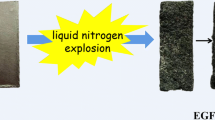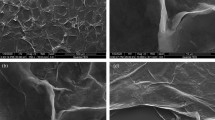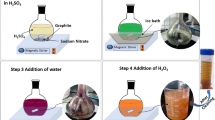Abstract
In this paper, a graphene/Fe2O3 (G/Fe2O3) modified anode was prepared through a simple one-step hydrothermal reduction method to improve the performance of microbial fuel cell (MFC). The power density of MFC with the G/Fe2O3 anode was 334 ± 4 mW/m2, which was 1.72 times and 2.59 times that of MFC with a graphene anode and an unmodified anode, respectively. Scanning electron microscopy and iron reduction rate experiment showed that G/Fe2O3 materials had good biocompatibility. Furthermore, microbial community analysis results indicated that the predominant populations on the anode biofilm belonged to Enterobacteriaceae, and the abundance of Desulfovibrio increased in the presence of the Fe2O3. Thus, the combination of graphene and Fe2O3 provided high electrical conductivity to facilitate extracellular electron transfer (EET) and improved biocompatibility to promote the cable bacteria formation and enhance electron transport efficiency over long distances. Therefore, G/Fe2O3 is an effective anode material for enhancing the performance of MFCs.








Similar content being viewed by others
Change history
09 December 2019
It has been brought to our attention that in our article, explanations about cable bacteria are not rigorous. We apologize for these and note the specific reporting issues and errors below, with their corrections.
References
Kakarla R, Min B (2014) Photoautotrophic microalgae scenedesmus obliquus attached on a cathode as oxygen producers for microbial fuel cell (MFC) operation. Int J Hydrog Energy 39:10275–10283
Logan BE (2009) Exoelectrogenic bacteria that power microbial fuel cells. Nat Rev Microbiol 7:375–381
Wang HY, Wang GM, Ling YC, Qian F, Song Y, Lu XH, Chen SW, Tong YX, Li Y (2013) High power density microbial fuel cell with flexible 3D graphene-nickel foam as anode. RSC 5:10283–10290
Juang DF, Yang PC, Chou HY, Chiu LJ (2011) Effects of microbial species, organic loading and substrate degradation rate on the power generation capability of microbial fuel cells. Biotechnol Lett 33:2147–2160
Logan BE, Hamelers B, Rozendal R, Schröder U, Keller J, Freguia S, Aeltermann P, Varstraete W, Rabaey K (2006) Microbial Fuel Cells: Methodology and Technology. Environ Sci Technol 40:5181–5192
Mehdinia A, Ziaei E, Jabbari A (2014) Multi-walled carbon nanotube/SnO2 nanocomposite: a novel anode material for microbial fuel cells. Electrochim Acta 130:512–518
Santoro C, Guilizzoni M, Baena JP, Pasaogullari U, Casalegno A, Li B, Babanova S, Artyushkova K, Atanassov P (2014) The effects of carbon electrode surface properties on bacteria attachment and start up time of microbial fuel cells. Carbon 67:128–139
Yu YY, Yong YC, Guo CX, Song H, Li CM (2014) Nitrogen doped carbon nanoparticles enhanced extracellular electron transfer for high-performance microbial fuel cells anode. Chemosphere 140:26–33
Reshetenko TV, Kim HT, Krewer U, Kweon HJ (2007) The effect of the anode loading and method of MEA fabrication on DMFC performance. Fuel Cells 7:238–245
Stankovich S, Dikin DA, Dommett GHB, Kohlhaas KM, Zimney EJ, Stach EA, Piner RD, Nguyen SBT, Ruoff RS (2006) Graphene-based composite materials. Nature 442:282–286
Li D, Müller MB, Gilje S, Kaner RB, Wallace GG (2008) Processable aqueous dispersions of graphene nanosheets. Nat. Nanotechnol 3:101–105
Xiao L, Damien J, Luo JY, Jang HD, Huang JX, He Z (2012) Crumpled graphene particles for microbial fuel cell electrodes. J Power Sour 208:187–192
Wang Y, Zhao C, Sun D, Zhang JR, Zhu JJ (2013) Graphene/poly (3,4-ethylenedioxy-thiophene) hybrid as an anode for high-performance microbial fuel cells. ChemPlusChem 78:823–829
Kerisit S, Rosso KM, Dupuis M, Valiev M (2007) Molecular computational investigation of electron-transfer kinetics across cytochrome-Iron oxide interfaces. J Phys Chem C 111:11363–11375
Lower BH, Shi L, Yongsunthon R, Droubay TC, McCready DE, Lower SK (2007) Specific bonds between an iron oxide surface and outer membrane cytochromes MtrC and OmcA from Shewanella oneidensis MR-1. J Bacteriol 189:4944–4952
Wu D, Xing D, Lu L, Wei M, Liu B, Ren N (2013) Ferric iron enhances electricity generation by Shewanella oneidensis MR-1 in MFCs. Bioresour Technol 135:630–634
Beliaev AS, Saffarini DA, Mc Laughlin JL, Hunnicutt D (2001) MtrC, an outer membrane decahaem c cytochrome required for metal reduction in Shewanella putrefaciens MR-1. Mol Microbiol 39:722–730
Xiong Y, Shi L, Chen B, Mayer MU, Lower BH, Londer Y (2006) High-affinity binding and direct electron transfer to solid metals by the Shewanella oneidensis MR-1 Outer membrane c-type cytochrome OmcA. J Am Chem Soc 128:13978–13979
Jin YC, Qian J, Wang K, Yang XW, Dong XY, Qiu BJ (2013) Fabrication of multifunctional magnetic FePc@Fe3O4/reduced graphene oxide nanocomposites as biomimetic catalysts for organic peroxide sensing. J Electroanal Chem 693:79–85
Song TS, Cai HY, Yan ZS, Zhao ZW, Jiang HL (2012) Various voltage productions by microbial fuel cells with sedimentary inocula taken from different sites in one freshwater lake. Bioresour Technol 108:68–75
Tamura H, Goto K, Yotsuyanagi T, Nagayama M (1974) Spectrophotometric determination of iron (II) with 1,10-phenanthroline in the presence of large amounts of iron (III). Talanta 21:314–318
Song TS, Yan ZS, Zhao ZW, Jiang HL (2010) Removal of organic matter in freshwater sediment by microbial fuel cells at various external resistances. J Chem Technol Biotechnol 85:1489–1493
Moon IK, Lee J, Ruoff RS, Lee H (2010) Reduced graphene oxide by chemical graphitization. Nat Commun 1:73
Ferrar AC (2007) Raman spectroscopy of graphene and graphite: disorder, electron–phonon coupling, doping and nonadiabatic effects. Soild State Commun 143:47–57
Li S, Hu YY, Xu Q, Sun Z, Hou B, Zhang YP (2012) Iron and nitrogen-functionalized graphene as a non-precious metal catalyst for enhanced oxygen reduction in an air-cathode microbial fuel cell. J Power Sour 213:265–269
Song TS, Tan WM, Xie JJ (2018) Bio-reduction of graphene oxide using sulfate-reducing bacteria and its implication on anti-biocorrosion. J Nanosci Nanotechno 18:1–7
Greene AC, Patel BKC, Sheehy AJ (1997) Deferribacter thermophilus gen. nov., sp. nov., a novel thermophilic manganese and iron-reducing bacterium isolated from a petroleum reservoir. Int J Syst Bacteriol 47:505–509
Rabaey K, Lissens G, Siciliano SD, Verstraete W (2003) A microbial fuel cell capable of converting glucose to electricity at high rate and efficiency. Biotechnol Lett 25:1531–1535
Yoshida N, Miyata Y, Mugita A, Iida K (2016) Electricity recovery from municipal sewage wastewater using a hydrogel complex composed of microbially reduced graphene oxide and sludge. Materials (Basel) 9:742
Leenaerts O, Partoens B, Peeters FM (2009) Water on graphene: Hydrophobicity and dipole moment using density functional theory. Phys Rev B 79:235440
Logan BE, Regan JM (2006) Electricity-producing bacterial communities in microbial fuel cells. Trends Microbiol 14:512–518
Lovley DR (2006) Bug juice: harvesting electricity with microorganisms. Nat Rev Microbiol 4:497–508
Franz CMAP, Van Belkum MJ, Holzapfel WH, Abriouel H, Gálvez A (2007) Diversity of enterococcal bacteriocins and their grouping in a new classification scheme. FEMS Microbiol Rev 31:293–310
Ganesan A, Chaussonnerie S, Tarrade A, Dauga C, Bouchez T, Pelletier E, Le Paslier D, Sghir A (2008) Cloacibacillus evryensis gen. nov., sp. nov., a novel asaccharolytic, mesophilic, amino-acid-degrading bacterium within the phylum “Synergistetes”, isolated from an anaerobic sludge digester. Int J Syst Evol Microbiol 59:2003–2012
Holmes DE, Bond DR, O’Neil RA, Reimers CE, Tender LR, Lovley DR (2004) Microbial communities associated with electrodes harvesting electricity from a variety of aquatic sediments. Microb Ecol 48:178–190
Pfeffer C, Larsen S, Song J, Dong M, Besenbacher F, Meyer RL, Kjeldsen KU, Schreiber L, Gorby YA, El Naggar MY, Leung KM, Schramm A, Petersen N, Nielsen LP (2012) Filamentous bacteria transport electrons over centimetre distances. Nature 491:218–221
Roden EE, Urrutia MM (2002) Influence of biogenic Fe (II) on bacterial crystalline Fe (III) oxide reduction. Geomicrobiol J 19:209–251
Hou J, Liu Z, Zhang P (2013) A new method for fabrication of graphene/polyaniline nanocomplex modified microbial fuel cell anodes. J Power Sour 224:139–144
Huang LH, Li XF, Ren YP, Wang XH (2016) In-situ modified carbon cloth with polyaniline/graphene as anode to enhance performance of microbial fuel cell. Int J Hydrog Energy 41:11369–11379
Benetton XD, Navarro-Ávila SG, Figueiras C (2010) Electrochemical evaluation of Ti/TiO2-polyaniline anodes for microbial fuel cells using hypersaline microbial consortia for synthetic wastewater treatment. J New Mater Electrochem Syst 13:1–6
Wen Z, Ci S, Mao S, Cui S, Lu G, Yu K (2013) TiO2 nanoparticles-decorated carbon nanotubes for significantly improved bioelectricity generation in microbial fuel cells. J Power Sour 234:100–106
Mehdinia A, Ziaei E, Jabbari A (2014) Facile microwave-assisted synthesized reduced graphene oxide/tin oxide nanocomposite and using as anode material of microbial fuel cell to improve power generation. Int J Hydrog Energy 39:10724–10730
Liu Q, Yang Y, Mei X, Liu B, Chen C, Xing D (2018) Response of the microbial community structure of biofilms to ferric iron in microbial fuel cells. Sci Total Environ 631–632:695–701
Acknowledgments
This work was supported by the National Key Research and Development Program of China (2018YFA0901300), the National Natural Science Foundation of China (Grant No.: 21878150); the Key projects of modern agriculture in Jiangsu Province (Grant No.: BE2018394); Fund from the State Key Laboratory of Materials-Oriented Chemical Engineering (ZK201605) and the Jiangsu Synergetic Innovation Center for Advanced Bio-Manufacture.
Author information
Authors and Affiliations
Corresponding authors
Ethics declarations
Conflict of interest
The authors declare that they have no conflict of interest.
Additional information
Publisher's Note
Springer Nature remains neutral with regard to jurisdictional claims in published maps and institutional affiliations.
Rights and permissions
About this article
Cite this article
Fu, L., Wang, H., Huang, Q. et al. Modification of carbon felt anode with graphene/Fe2O3 composite for enhancing the performance of microbial fuel cell. Bioprocess Biosyst Eng 43, 373–381 (2020). https://doi.org/10.1007/s00449-019-02233-3
Received:
Accepted:
Published:
Issue Date:
DOI: https://doi.org/10.1007/s00449-019-02233-3




